CHURCH AND CHAPEL REGISTER TRANSCRIPTIONS
Undertaken by Craig Thornber
In Lancashire and Yorkshire, England

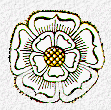
Nonconformist Chapels
Anglican Churches
1. Holden Chapel
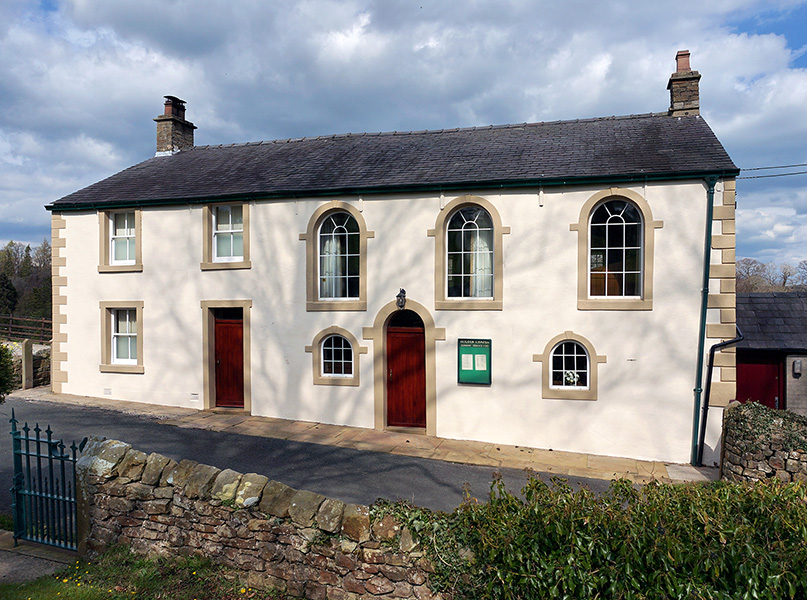 |
| Holden Chapel, April 2015 |
 |
| Opening of the new school at Holden Chapel |
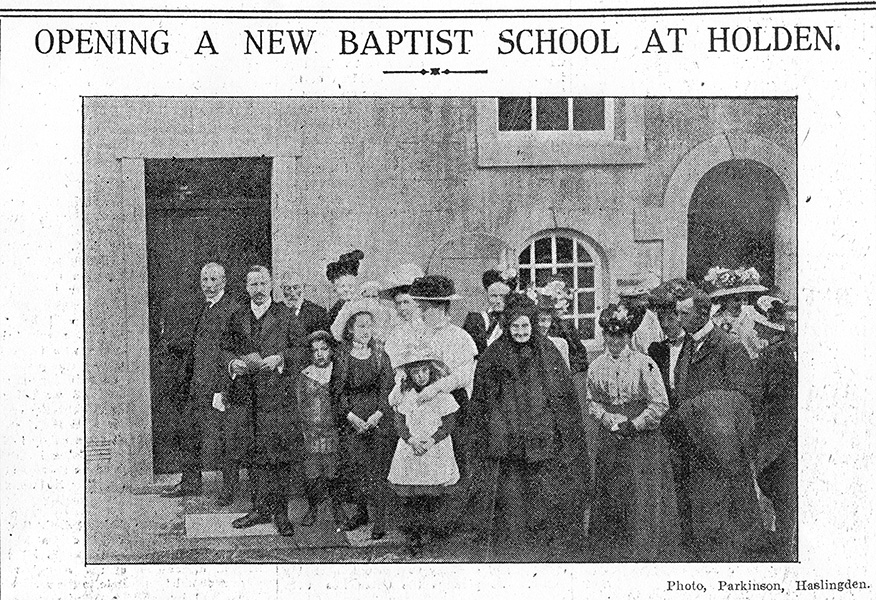 |
| Picture used by Accrington Observer & Times in September 1909 |
Holden is a small village about a mile west
of Bolton by Bowland, four miles west of Gisburn and five miles north of Clitheroe.
Until the local government reorganisation it was in the West Riding of Yorkshire
but is now in Lancashire. Holden Chapel was founded in 1766 for Protestant Dissenters
of the Presbyterian or Independent persuasion. Its story is told in History
of the Dales Congregational Churches, by Thomas Whitehead, published in Keighley
in 1930.
I am grateful to Reg Postelthwaite who kindly sent me the photograph of the opening of the new school premises at Holden Chapel in September 1909. It was taken from The Recollections of a Country Gentleman, by Richard Milne-Redhead, Esq, published in 1977. The event was reported in the Accrington Observer & Times in the issue of Tuesday 28 September mentioning that it took place the previous Saturday, 25th September. The paper refered, incorrectly as I believe, to the chapel being Baptist. The picture they published of the event showed a Mrs. Thornber, aged 94 who gave the keys of the new school to Mr. Waddington jr, in the absence of his father, Mr. R. Waddington. There were addresses by Mr. W. H. Duerden, Mr. McNeail and Mr. Slater.
The deed for the Chapel, dated 1st and 2nd January
1766, states that the land was to be used to build a Meeting House for Protestant
Dissenters of the Presbyterian or Independent persuasion. There were two parties
to the deed and the second party, which would be the original trustees, comprised
Henry Walkden of Gills Crofts near Clitheroe, clerk (minister); Richard Inskip
of Bay Gate; Richard Seed of Holden, smith; John Scott of Holden, wool comber;
Christopher Frankland of Holden, tailor; Thomas Fell of Twiston, yeoman; and
Robert Harrison of Peathorn, yeoman.
The registers have never been copied, filmed
or indexed. I have transcribing and edited them with the permission of the chapel
trustees. The transcript was checked against the original register by Sue Holden,
Reference Librarian at Clitheroe. There are no marriages but there are baptisms
and burials between 1771 and 1897. In the first register there are 509 baptisms
and 70 burials. The second register contains 428 baptisms and 248 burials.
Copies of the registers have been sent to: Libraries
in the Burnley Division of Lancashire, Skipton Library, Lancashire County Record
Office; North Yorkshire Record Office at Northallerton; Yorkshire Archaeological
Society headquarters at Claremont, Leeds; Lancashire Family History and Heraldry
Society; Manchester and Lancashire Family History Society; Society of Genealogists,
The Family Records Centre in London.
In the course of visiting Holden Chapel I noted
the following memorials to Dissenting Ministers. The Revd. Sowden was instrumental
in setting up Mount Sion Chapel at Tosside and was minister at the chapel at
Horton in Ribblesdale.
In Memory of the Revd. Henry Driver for 17
years respected Pastor of this church who died June 11 1860 in the 80th year
of his age. Also of Betty, wife of the above who departed this life March
11, 1811 aged 52 years.
Here lieth the body of the Revd. Benjamin Sowden, late minister of Horton
in the Parish of Gisburn, who departed this life February 7 1813 aged 64.
Also Esther Sowden, wife of the above, who died June 14 1833 aged 84.
Here lieth intombed the remains of the Revd. John Gauber who departed this
life the 6th day of May 1804 aged 85 years.
Thornber records
at Holden
2. Mount Sion Chapel at Sandy Syke, Tosside
Tosside is a village north of Bolton by Bowland
and east of Slaidburn. The Mount Sion Chapel was founded in 1812. With the permission
of the Secretary of the Chapel Trustees I have transcribed and indexed the registers.
The section of the transcript on baptisms was checked by Mrs. Sue Holden, reference
librarian at Clitheroe. There are baptisms from about 1812 and burials
from 1838. Records of an additional 20 burials prior to 1838 have been located
at the Public Record Office and have been included in the transcript.
These registers have not been filmed but the baptisms from 1812 to 1837 have
been indexed by the I.G.I. under the name Gisburn Sandy Syke Independent. Copies
have been deposited at Lancashire County Archives, North Yorkshire County
Record Office, Manchester Central Library, Manchester and Lancashire Family
History Society, The Society of Genealogists, The Yorkshire Archaeological Society,
The Family Record Centre in London and libraries in the Burnley Division of
Lancashire. The 18 Thornber entries are listed
in the archive section.
Prior to the construction of Mount Sion in 1812,
people met for worship at the home of Giles Thornber
of Sandy Syke. I am grateful to Mrs. Shorrock of Settle in North Yorkshire for
a photograph of the old farm at Sandy Syke, which has now been demolished. The
History of the Dales Congregational Chapels, by Thomas Whitehead, published
in 1930, states that the meetings were at the home of Miles Thornber at Higher
Sandy Syke. No Miles Thornber has been found in all my researches into the Thornbers
but a Giles is known to have lived at Sandy Syke (though not specifically at
Higher Sandy Syke) from his will. It seems likely that Whitehead misheard the
name or that a misprint was overlooked. Giles father, Ralph Thornber lived at Lower Sandy Syke as shown by the baptism entry for his son William in the Slaidburn registers.
Wm. s. Ralph Thornber of Lower Sandy Sike Gisborne Forest, 26 Nov 1749.
Article from the Clitheroe Advertiser and Times of 23 September 1960 by William R. Mitchell (the author of Exploring the Ribble Valley between Ribblehead and Clitheroe)
Chapel in the hills serves a noble purpose
There is a chapel on the wild fringe of Bowland that has bowed to modernity only in the sense of acquiring electric lights, and even then and oil lamp has been shrewdly retained against the possibility of power failures. Mount Sion, Tosside, is excitingly old-fashioned. It has remained outside the blundering grip of the restorer. The pulpit is high and long, like the bridge of a small coaster. A huge stove would frizzle anything up withing three yards. It sends a wave of heat towards the door. The pipe carrying away the smoke rises vertically for more than 20 feet and then makes a rusty, conspicuous way to one of the walls. The tall brown pews, shiny with varnish, have close-fitting doors. In a large enclosure, just in front of the pulpit lies a harmonium. Each Sunday, the keys are strummed by Mrs. William Askew. The sole item of adornment, if you except portraits of two ancient pastors, is a marble war memorial plaque which adheres to the wall high above the rostrum.
Mount Sion was built in 1812. As you wander through the building the year might still be 1812. Yet the chapel nobly serves a scattered farming community. There is a warmth and homeliness. An here is the Christian spirity of timelessness. Mrs. William Capstick, a farmer's wife, is the secretary of this remote high-lying chapel. Mr. Luke Lawson, of Throstle Nest Farm, who is six decades old, has been going to services "since I could toddle". The changes he has seen have been mainly to the congregation rather than the building. There is one service each Sunday, often conducted by local Methodist preachers, for now there is no resident pastor. Tosside was in the old Forest of Gisburn. Christianity gained a foothold in these parts with Houghton Chapel, which was connected with the church at Gisburn. Three hundred years ago there was a suggestion it should be made a parish church, but nothing came of it then. Nor was there success in having it certified as "a chappel for Dissenters. Congregationalism began with meetings in private houses.
By 1812, when services were held at the home of Miles Thornber, Higher Sandy Syke, between 200 and 300 regularly heard the gospel preached and many of them had travelled for mles along poor tracks and roads. The Rev. Benjamin Sowden, minister at Horton-in-Craven was the man who built up this interest. That year, the present chape was built. An unknown well-wisher dropped a £5 note in the collection box. Mr. Sowden built up the congregation. He laid the foundation stone of the chapel. Yet he was not invited to become the pastor. And when he heard this was not to be, he fell sick and died after a few days. The first pastor was in fact the Rev. Hugh Hart, who was ordained in 1814. Tosside never casts away the loneliness of the old forest days. One night in the early 1880s, the minister, the Rev. John Robinson, was returning to the manse, part of the church building, after preaching at Settle, when a big black dog began to follow him. As the minister passed along a stretch of road through a gloomy wood, two men sprang out on him to rob him but the black dog drove them away. The dog spent the night at the manse, but when it left next day it was never seen again. Tosside chapel has changed little with the years. Yet here you sense the timeless spirit of Christianity, which is itself unchanged after almost 2000 years.
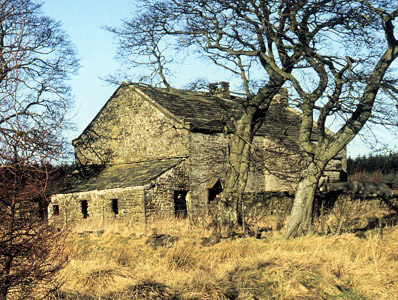 |
 |
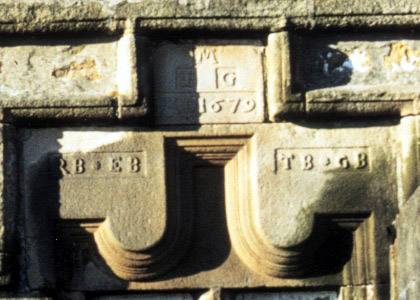 |
| Sandy Syke Farm |
|
Lettering over the window with date of 1679 |
3. Rodhill Inghamite Chapel Registers
I have transcribed the Registers
of Rodhill Inghamite Chapel near Grindleton, north of Clitheroe. The original
registers are held at the headquarters of the Yorkshire Archaeological Society
in Leeds. I am grateful to the Society Archivist, Mrs. S. Thomas, for permission
to transcribe and publish these registers. There are about 100 baptisms and 125 burials from
1754 to the 1830's. Copies have been deposited as for the Holden Chapel
Registers.
The following brief account of the Inghamites
is condensed from the entry in The Dictionary of Genealogy, by
Terrick Fitzhugh, Revised Edition, Alphabooks, 1988.
"The Inghamites were a small Nonconformist
sect founded by Benjamin Ingham (1712-1722). Ingham's group was founded in 1754,
when he and his followers broke away from the Moravians. A year later they had
a large number of followers, mostly in Lancashire and Yorkshire, and broke away
from the Church of England. Ingham became influenced by the ideas of the Scottish
Sandeman sect and this caused the break up of his group in 1763; some became
Methodists, some Sandemanian and some Baptists. However, a few societies remained
loyal. In 1814 they amalgamated with the Daleites of Scotland and the church
still survives today in Yorkshire, Lancashire and Cumbria. In 1840, eight Inghamite
baptismal and burial registers were deposited at the General Record Office and
are now at the Public Record Office."
The following information
on the Inghamites is adapted from The Annals and Stories of Barrowford,
by Jesse Blakey (see Select Bibliography)
Benjamin Ingham, the founder of the
Inghamites, was born in 1712 at Ossett near Wakefield in Yorkshire. Educated
at Oxford, he became acquainted with the Wesleys. Ingham was ordained in 1735,
and began to work in London but was soon persuaded to accompany the Wesleys
on their missionary journey to Georgia.
In 1744 Ingham married Lady Margaret Hastings,
sister of Lady Huntingdon. He began his own sect, assuming the position of
general overseer. In his preaching around the country he was helped by three
brothers, the Battys of Newby Cote near Settle in Yorkshire. Ingham's preaching
angered the Rev. George White, vicar of Colne, the man who had persecuted
John Wesley. Ingham died in Aberford in 1772. Of the societies which remained
loyal, the majority are in the area of Nelson and Colne. The chapel at Wheatley
Lane is the oldest being built in 1749-50. Preachers came from Colne, Winewall,
Rodhill and Todmorden. Pews were first installed in 1789 and the chapel was
reopened after extensive alterations in 1898.
In late 1998, Paul Oates of Ribchester produced a report on his research into
Rodhill Inghamite Chapel. This has now been published in 2 articles in
Lancashire History Quarterly, Vol 3 Issues No. 3 and 4,
1999, published by Hudson History of Settle. Paul went on to produce a monograph My Ancestors were Inghamites, by Paul J Oates, published by Society of Genealogists Enterprises, Ltd. 14 Charterhouse Buildings, Goswell Road, London EC1M 7BA, 2003. ISBN 1 903462 77 0
Another recent source of information on the Inghamite
movement is the book Benjamin Ingham, by H M Pickles, Pioneer Press, Skipton, 1995, ISBN 0 9526950 0 6. This book covers both the history of the Inghamites and the finer points of doctrinal disputes so is of more interest to those with a theological bent.
If you would like a full transcript of the Rodhill register, which is only a few pages, I will send it to you free of charge
by E-mail as a pdf file to view in Adobe Acrobat Reader.
4. Higham Wesleyan Chapel
In the early 1920s, Dr. John Laycock of Sabden and some associates made a hand-written copy of Higham Methodist Chapel records, covering the baptisms from 1813 to 1839 and the burials from September 1820 to April 1864. Hardly any of the transcript is in Dr. Laycock's hand. The ledger containing the transcript is owned by Burnley Library who have kindly made it available to me for typing. A typed version in tabular format has now been completed and checked against the original register at the Lancashire County Record Office. The baptisms and burial tables have been rearranged in alphabetical order. Burnley Library will make copies for local libraries. I have made copies for Manchester Central Library, Lancashire County Record Office, the Society of Genealogists, The Family Records Centre, the library of the Lancashire Family History and Heraldry Society, the Burnley & Pendle Branch of the LFH&HS and Blackpool Library.
5. Wheatley Lane Inghamite Chapel
In the early 1920s, Dr. John Laycock of Sabden and some associates made a hand-written copy of Wheatley Lane Inghamite chapel records, covering the baptisms from August 1751 to September 1866 and burials from December 1750 to June 1837. Hardly any of the transcript is in Dr. Laycock's hand. The ledger containing the transcript is owned by Burnley Library who have kindly made it available to me for typing. With the agreement of the Revd: Matthew Butler, the transcript has been checked against the original registers. The transcript has been indexed using the Lancashire Parish Register Society programme, PRINDEX, written by George Blundell. The work was completed at the end of September 2006. Burnley Library will make copies available to the public libraries in the district and I have provided copies to other record offices and libraries as for the Higham Wesleyan Chapel.
I have put a brief history of the Chapel on a separate page.
6. Houghton Chapel, at Tosside, Gisburn Forest.
Houghton Chapel, also known as Tosside Chapel,
was a chapel-of-ease for Gisburn St Mary's. The baptism records for this chapel
have been indexed up to 1837 by the IGI under the name of Houghton by Settle.
By permission of the Rev. Mark Russell-Smith, I have transcribed all the baptisms
and burials from the commencement in 1749 to 1851. A few records from the period
between 1749 and 1769 are contained in the registers of St. Mary's, Gisburn, and
were included in the Yorkshire Parish Register Society's Vol. 114, published in
1943. I am grateful to Mrs. Sue Holden, reference librarian at Clitheroe
library for help in identifying some of the place names. Copies of my transcription
have been donated to the Lancashire County Archive, North Yorks County Record
Office, Soc. of Genealogists, Yorkshire Archaeology Society at Leeds, Family Records
Centre in London, libraries in the Burnley District, Skipton library, The Borthwick
Institute of Historical Research in York, and the Clitheroe branch of the Lancashire
Family History and Heraldry Society. Thornber
records are shown in the archive section.
Article from the Clitheroe Advertiser and Times of 12 August 1960 by William R. Mitchell
Vicar has Three Churches in his Remote Parish
Distance is one of the great problems confronting clergyman in an undulating countryside like Bowland. At Slaidburn, the Rector, the Rev. G. H. Gaze supervises what might be the largest parish in England - 40,000 acres, with more than 40 Acres for each person living in it - and neighbouring Tosside covers 30 square miles. The Vicar, the Rev. R. C. Allan, finds that a car is essential if he is to see his parishioners regularly and takes services at three remote places of worship. Mr. Allan does not yearn for gentler country and bigger centres of population. He speaks enthusiastically about curlew-haunted fells and a remarkably panoramic view which can be had from the roomy vicarage. This ranges from Ingleborough in the north round to the high places around Skipton, and from Pendle Hill, looming up beyond Ribblesdale, to the Bowland Fells. Apart from Tosside Church there are two other places of worship - Burnridge Mission Church, about two and a half miles away, and St. James's Dalehead, four and a half miles distant
This is forest country. The earliest record in the religious history of Tosside relates to a chapel-of-ease to Gisburn Church, known as Houghton Chapel in Tosside. Like most country vicarages today, the building at Tosside is more than adequate for the vicar. There might have been many empty rooms but he has made five upstairs rooms available to the youth of the parish and they are mainly farm children. Once every fortnight, a thriving undenominational youth group with a membership of 30 gathers here, and some of them cycle for miles to attend the meetings. At the Vicarage too meets the Tosside Sunday School. To create mighty Stocks Reservoir, the Fylde Water Board flooded a small green valley and evacuated its inhabitants, including those who had died down the years, for there was a distinct possibility of the church getting its feet wet and around the church was a graveyard. The present St. James's Church, Dalehead, was opened in 1938 and Mr. Allan regularly conducts services here. He hears tales from the local people about the old church, which presided over a village of about 20 cottages, a shop, post office, public house and smithy.
That church had been consecrated in October 1852, and the site had been given by William Wilkinson of Hellifield, who also made an endowment of £50 a year. At Burnridge Mission Church, there are memories of a famous North Country Evangelist, Benjamin Ingham. In the days when the Inghamites had a strong following in the fell country, the building was known as New House Chapel, having been built in 1839 on part of New House Estate, Gisburn Forest. Anglicans have been worshipping at Burnridge for close on a century. The friendly grey-haired Vicar of Tosside, does not find it easy to minister to a scattered population, especially as some of the homes are at the end of long rutted tracks. All the problems of distance are accentuated in winter, when the fells have been powdered white with snow. Yet when he looks from his vicarage at populous valleys, he does not envy lowlanders. Mr. Allan is a lover of the hills, and the sturdy, independent hill folk.
For a fuller account of the chapel and its registers I reproduce the Introduction to my transcript.
7. All Hallows, Mitton, formerly Yorkshire, now in Lancashire.
By permission of the Reverend J. T. Birbeck,
Phil Marsden and I have transcribed the registers of Mitton All Hallows. Phil
Marsden made an initial transcript of the registers from 1610 to 1719, some
of which are in very poor condition, using the film version. These records have
not been indexed by the IGI. I have checked the initial draft against
the original register using UV light where appropriate to help interpret faded
entries. The transcript has been checked against the bishops' transcripts on
film at Preston and against the originals at the Borthwick Institute. The editing
and indexing has been completed and the whole printed and produced as a hard
back book of 153 pages of A4. A microfiche version of this transcript was produced by the Lancashire Parish Register Society in 2006.
In addition, I worked on the period from 1720
to 1812. Initially the baptisms and burials were produced in tabular form rearranged
in alphabetical order of surname. However, I have completed versions in date
order with full indexes. The work has been published in three volumes for baptisms,
marriages and burials. Copies of these transcripts have been donated
to Clitheroe Library, Lancashire County Archive, The Borthwick Institute
for Historical Research in York, Yorkshire Archaeological Society in Leeds,
The North Yorkshire County Record Office in Northallerton, and the Society of
Genealogists in London. Lancashire libraries have purchased copies for other
libraries in the Burnley district.
These transcripts were published on CD ROM by the Lancashire Parish Register Society in 2007.
Thornber records at Mitton
are shown in the Archive Section.
8. St. Mary and All Saints,
Whalley, Lancashire, 1653 to 1837.
The Parish Registers of St. Mary and All Saints,
Whalley, are preserved at the Lancashire County Archive in Preston. The
Lancashire Parish Register Society has published two volumes of the Whalley
registers, Volumes 7 and 74, covering the period from 1538-1653. The
International Genealogical Index covers baptisms at Whalley from 1538-1875 and
marriages from 1539-1601 and 1605-1837. There is a manuscript index to the registers
at the County Archives covering baptisms from 1538-1569 and from 1691-1888;
marriages from 1700-1847; and burials from 1740-1886. As a consequence of this
coverage there was a need for further work to transcribe and index the registers
fully from 1653 onwards.
Dr. John Alfred Laycock produced a handwritten transcript of Whalley registers
in 1902 and this is preserved at the Public Library in Burnley. The transcript
is in very clear script and it is evident that Dr. Laycock was meticulous in
his work. He prepared full transcripts of other registers in the area and was
the author of "A Guide to the Genealogy of the Country Around Pendle".
Laycock's transcript has recently been filmed by Burnley Library and this has
presented the opportunity to use the original for the first stage of a full
transcript of the registers. Access to the Laycock work has allowed easier and
quicker progress than use of the original register at Preston and has taken
advantage of the fact that Laycock viewed the registers when they were a century
younger.
The following reports have been produced for Burnley Library.
First Phase: 1653 to 1739
Burials from 1653 to 1739, rearranged in alphabetical order, August 2003
Baptisms from 1653 to 1739, rearranged in alphabetical order, September 2003
Marriages from 1653 to 1739, in two tables, one rearranged in groom order
and one in bride order, October 2003
Second Phase: 1740 to 1812
Baptisms 1740 to 1812, rearranged in alphabetical order, January 2004
Marriages 1740 to 1812, in two tables, one rearranged in groom order and one
in bride order, June 2004
Burials 1740 to 1812, rearranged in alphabetical order, September 2004
Third Phase: 1813 to 1837
Baptisms 1813 to 1837, rearranged in alphabetical order, January 2005
The Reverend Councillor Chris Sterry, Vicar of Whalley, gave his support
for the preparation of versions suitable for publication by the Lancashire Parish
Register Society. This involved converting the tables in date
order form into text format by simple word processor commands. The draft was cross-checked against the original register and then against the
bishops' transcripts, both of which are at the County Archive in Preston.
Two volumes, covering the period 1653 to 1753, and 1754 to 1812 have been published. The first is Volume 162 in the LPRS series and was published in July 2006. The second is Volume 164, which was published in November 2006. A further section covering 1813 to 1837 was published in October 2009 as Volume 171.
9. St. Nicholas, Newchurch-in-Rossendale from 1606-1812
The Lancashire Parish Register Society has a handwritten transcript of such registers as survive from 1723, prepared in the early 1950s by Dr. Milton Ormerod. Most of the periods for which the registers are missing are covered by the BTs. In addition to the registers, Dr. Ormerod consulted paper copies kept by some of the incumbents and these often had additional details of abodes. I have typed his transcript of the records from 1723 to 1762, checked it against the originals and the BTs and against the curate's paper copies. The work has now been extended from the BTs to create a volume covering 1723-1772, published by the Lancashire Parish Register Society on CD ROM as Volume NC 2.
There is period of about forty years from 1762 in which the baptism and burial registers are missing and the records have been transcribed from the BTs. A further volume covering 1773 to 1812 was publised by the LPRS on CD ROM as Volume NC4 in September 2009.
The registers from 1653 to 1722 were transcribed in 1912 and form Volume 45 of the LPRS series; these registers are incomplete and were not collated with the bishops' transcripsts. I have now collated this register with the bishops' transcripts. The registers before 1653 are lost but there survive twenty years of bishops' transcripts in the period from 1606 to 1640 which I have transcribed to create a volume that covering 1606 to 1722, which was published by the Lancashire Parish Register Society in hardback in 2010 as Volume 45a.
10. St. John the Evangelist, Bacup, 1788-1812, Baptisms and Burials only
From 1788, St. John the Evangelist at Bacup began as a chapel of ease for Newchurch-in-Rossendale and performed baptisms and burials. The records from Bacup and Newchurch are combined into a single list in the Bishops's transcripts so to identify those belonging to Newchurch in the period up to 1797 for baptisms and 1803 for burials, it has been necessary to transcribe those of Bacup and subtract them from the BT listing. This now forms the basis of a transcript of Bacup from 1788 to 1812. It was published by the Lancashire Parish Register Society on CD ROM in April 2010.
The End







